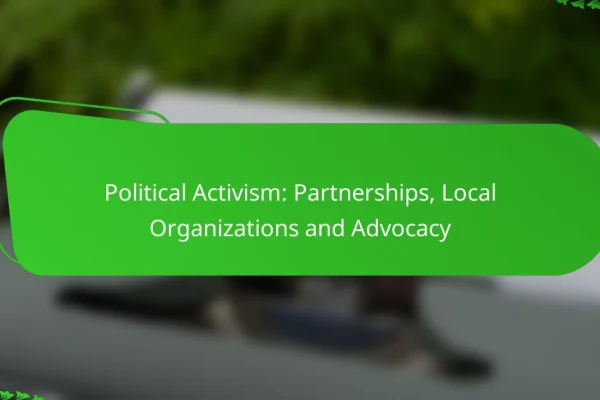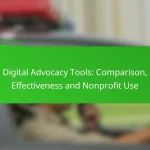How to build effective coalitions in the United States?
Building effective coalitions in the United States involves aligning diverse groups around common objectives to achieve shared goals. This process requires strategic planning, active engagement, and clear communication among all stakeholders involved.
Identify shared goals
Identifying shared goals is crucial for coalition building. Start by bringing together potential partners to discuss their priorities and aspirations, ensuring that all voices are heard. Focus on common interests that can unify the group, such as community development, environmental sustainability, or social justice.
Once shared goals are established, document them clearly to guide coalition activities. This documentation serves as a reference point for decision-making and helps maintain focus on the coalition’s mission.
Engage stakeholders
Engaging stakeholders is essential for a successful coalition. Identify key individuals and organizations that have a vested interest in the coalition’s goals. This may include community leaders, local businesses, non-profits, and government representatives.
Utilize outreach strategies such as meetings, workshops, and social media to foster relationships and encourage participation. Make sure to create an inclusive environment where stakeholders feel valued and motivated to contribute.
Establish clear communication
Clear communication is vital for maintaining cohesion within a coalition. Develop a communication plan that outlines how information will be shared among members. This plan should include regular updates, feedback mechanisms, and designated points of contact.
Utilize various communication channels, such as emails, newsletters, and group meetings, to keep everyone informed and engaged. Consistent communication helps build trust and ensures that all members are aligned with the coalition’s objectives.
Leverage existing networks
Leveraging existing networks can enhance the effectiveness of a coalition. Identify organizations and groups that already have established relationships and resources that align with your coalition’s goals. Collaborating with these networks can provide valuable insights and support.
Consider forming alliances with local advocacy groups, businesses, and educational institutions to expand reach and influence. These partnerships can amplify your coalition’s voice and increase its impact on the community.
Utilize digital collaboration tools
Digital collaboration tools are essential for facilitating communication and coordination among coalition members. Platforms like Slack, Microsoft Teams, or Google Workspace can streamline discussions, document sharing, and project management.
Choose tools that fit the needs of your coalition and ensure that all members are trained on how to use them effectively. Regularly assess the tools being used to ensure they continue to meet the coalition’s evolving needs and enhance productivity.
What are the benefits of partnerships for organizations?
Partnerships provide organizations with numerous advantages, enhancing their capabilities and effectiveness. By collaborating, organizations can leverage shared resources, increase their credibility, and expand their reach and impact in their respective fields.
Increased resources
Partnerships allow organizations to pool their resources, including funding, expertise, and technology. This collaboration can lead to cost savings and more efficient use of assets, enabling projects that may not be feasible independently.
For example, two non-profits might combine their grant funding to launch a community initiative, maximizing their impact while minimizing individual financial risk. Organizations should assess their needs and seek partners that can complement their resource gaps.
Enhanced credibility
Collaborating with established organizations can significantly boost an entity’s credibility. Partnerships often signal trust and reliability to stakeholders, clients, and the public.
For instance, a small startup partnering with a well-known industry leader can enhance its reputation and attract more customers. Organizations should choose partners whose values align with theirs to maintain authenticity and trustworthiness.
Broader reach and impact
Partnerships can help organizations extend their reach into new markets or demographics. By combining networks, organizations can access a wider audience and create a more significant impact.
For example, a local charity partnering with a national organization can leverage the latter’s extensive network to promote its initiatives. Organizations should identify potential partners that can help them reach their target audiences effectively and strategically.
What strategies enhance coalition effectiveness?
Effective coalition building relies on strategies that foster collaboration, communication, and shared goals among partners. Key approaches include regular evaluation, conflict resolution mechanisms, and inclusive decision-making processes.
Regular evaluation and feedback
Regular evaluation and feedback are essential for maintaining coalition effectiveness. By assessing progress and outcomes, partners can identify strengths and areas for improvement. This process should occur at set intervals, such as quarterly or bi-annually, to ensure timely adjustments.
Implementing feedback loops allows coalition members to voice concerns and share insights. This can be facilitated through surveys, meetings, or informal check-ins, ensuring that all voices are heard and valued.
Conflict resolution mechanisms
Establishing clear conflict resolution mechanisms is vital for addressing disputes within a coalition. These mechanisms should outline steps for resolving disagreements, such as mediation or facilitated discussions, to prevent escalation and maintain focus on shared objectives.
Coalition partners should agree on a process that includes identifying the issue, discussing possible solutions, and reaching a consensus. Having a neutral third party can also help facilitate resolution when necessary, ensuring that all parties feel respected and heard.
Inclusive decision-making processes
Inclusive decision-making processes enhance coalition effectiveness by ensuring that all partners contribute to key decisions. This approach fosters a sense of ownership and commitment among members, which can lead to more innovative solutions and stronger collaboration.
To implement inclusive decision-making, consider using consensus-building techniques or structured brainstorming sessions. It is important to create an environment where all members feel comfortable sharing their perspectives, which can be achieved through active listening and encouraging diverse viewpoints.
How to choose the right partners for coalition building?
Choosing the right partners for coalition building involves identifying organizations that share similar goals and values, possess complementary strengths, and are relevant to your geographic area. This strategic alignment enhances the coalition’s effectiveness and sustainability.
Assess alignment of values
Start by evaluating the core values and mission statements of potential partners. Ensure that their objectives resonate with your own to foster a unified approach. Misalignment in values can lead to conflicts and undermine the coalition’s purpose.
Consider conducting interviews or surveys to gauge the cultural fit between organizations. This can help identify shared beliefs and priorities, which are crucial for a successful partnership.
Evaluate complementary strengths
Identify the unique strengths and resources each partner brings to the coalition. This might include expertise, funding capabilities, or community connections. A diverse set of strengths can enhance the coalition’s overall impact.
For example, one partner may excel in advocacy while another has strong grassroots mobilization skills. Combining these strengths can create a more robust coalition that addresses various aspects of the issue at hand.
Consider geographic relevance
Geographic relevance is essential for effective coalition building. Partners should ideally operate within the same region or community to ensure that their efforts are aligned with local needs and conditions. This proximity can facilitate collaboration and enhance outreach efforts.
Evaluate the specific challenges and opportunities within the geographic area. Understanding local dynamics can help tailor strategies and initiatives that resonate with the community, making the coalition more effective in achieving its goals.
What are common challenges in coalition building?
Coalition building often faces several challenges that can hinder collaboration and effectiveness. Key issues include managing diverse stakeholder interests, conflicts over resource allocation, and overcoming communication barriers.
Diverse stakeholder interests
In coalition building, diverse stakeholder interests can create friction and complicate decision-making. Each participant may have unique goals, priorities, and values, which can lead to disagreements on the coalition’s direction.
To navigate these differences, it is essential to establish a clear common purpose and set shared objectives. Regular discussions and negotiations can help align interests and foster a sense of ownership among all parties involved.
Resource allocation conflicts
Resource allocation conflicts arise when coalition members compete for limited resources, such as funding, personnel, or time. These conflicts can strain relationships and disrupt coalition activities if not managed effectively.
To mitigate these issues, coalition leaders should develop transparent criteria for resource distribution and encourage open dialogue about resource needs. Creating a shared budget or pooling resources can also help alleviate tensions.
Communication barriers
Effective communication is crucial in coalition building, yet barriers such as differing communication styles, jargon, and cultural misunderstandings can impede collaboration. These challenges can lead to misinterpretations and frustration among coalition members.
To enhance communication, establish clear channels and protocols for sharing information. Regular meetings and updates can help ensure that all stakeholders are informed and engaged, fostering a collaborative atmosphere.






